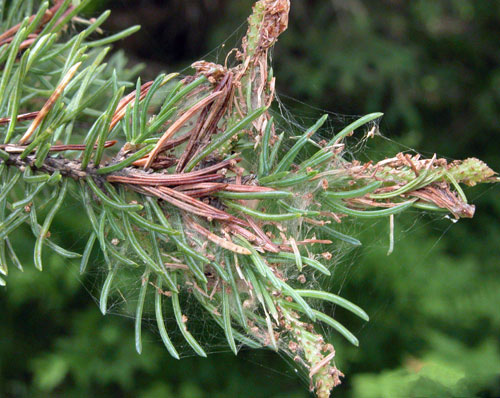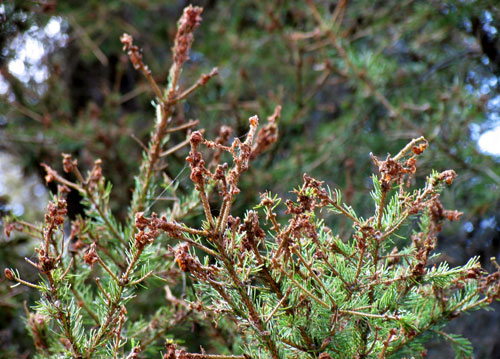Scout now for spruce budworm feeding on new growth
During outbreak years, feeding by spruce budworm caterpillars can cause severe defoliation to spruce and fir Christmas trees.
In 2012, Christmas tree growers in the western Upper Peninsula of Michigan and Wisconsin reported heavy damage to Fraser and balsam fir from spruce budworm. Spruce budworm (Choristoneura fumiferana) is a native defoliator that typically feeds on balsam fir, white spruce and occasionally Colorado blue spruce.
Epidemics of spruce budworm periodically cause extensive damage and tree mortality in spruce and fir forests across the northeastern United States and Canada. Historically, epidemics have occurred on a 30-year to 50- year cycle. Outbreaks typically last 10 to 15 years and the last epidemic ended in Michigan in 1982.

Spruce budworm larvae feeding. Photo credit: Joseph O’Brien, USDA Forest Service, Bugwood.org
According to the MDNR Forest Health Report, new areas of budworm defoliation were discovered in the Upper Peninsula in 2012. This outbreak follows a reduction in spruce budworm activity in 2011, which followed alarmingly widespread infestations in 2010.It is uncertain if the increase in spruce budworm activity over the last few years in the Upper Peninsula is a precursor to the next large scale event.

Damage from spruce budworms. Photo credit: Joseph O’Brien, USDA Forest Service, Bugwood.org
Spruce budworm has one generation per year. Eggs are laid on the needles of balsam fir and white spruce in late July and August. After hatching, the tiny caterpillars are dispersed within the canopy by either wind or crawling. The caterpillars then spin overwintering shelters in the canopy, molt and remain dormant until the following spring. The larvae remain in hibernation until May (200 to 300 GDD50) when they will emerge, disperse again then begin feeding. As the new growth expands, the caterpillars grow and feed on these new shoots. They will continue feeding on these shoots and spin a small web that serves as a feeding shelter.
Michigan State University Extension advises growers in the Upper Peninsula to begin scouting trees for budworm activity. Treatment should begin when the larvae have emerged and repeat treatment in seven to 10 days if needed.



 Print
Print Email
Email

